Tokina AF 12-24mm f/4 AT-X 124 Pro DX MkII
Tokina AF 12-24mm f/4 AT-X 124 Pro DX MkII: Performance
At 12mm, this lens produces images of excellent clarity across the frame from maximum aperture. Stopping down to f/5.6 further improves the sharpness to outstanding levels, so much so that diffraction starts to reduce sharpness levels at smaller apertures.At 18mm, the performance remains similar at maximum aperture, with outstanding sharpness in the centre of the frame and very good sharpness towards the edges. At this focal length, peak quality is achieved at f/5.6, just like at 12mm.
At 24mm, the quality towards the edges of the frames dips to fair levels at maximum aperture, although the clarity in the centre is still very good. At this focal length, the quality towards the edges improves as the lens is stopped down, peaking at f/16, where very good sharpness is achieved across the frame.
| Resolution at 12mm | Resolution at 18mm | |
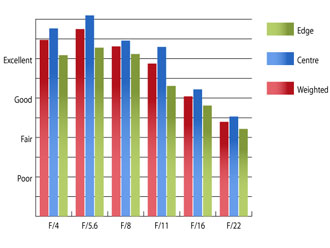 | 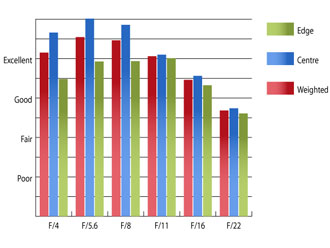 | |
| Resolution at 24mm | How to read our graphsThe blue column represents readings from the centre of the picture frame at the various apertures and the green is from the edges. Averaging them out gives the red weighted column.The scale on the left side is an indication of actual image resolution. The taller the column, the better the lens performance. Simple. For this review, the lens was tested on an Nikon D300 using Imatest. | |
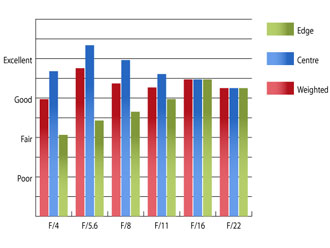 |
Unfortunately, chromatic aberrations towards the edges of the frame are not very well corrected. At 12mm and f/4 they exceed three pixel widths, which will be clearly visible around high contrast edges towards the edges of the frame.
| Chromatic Aberrations at 12mm | Chromatic Aberrations at 18mm | |
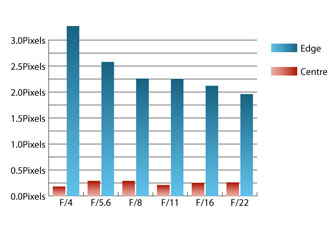 | 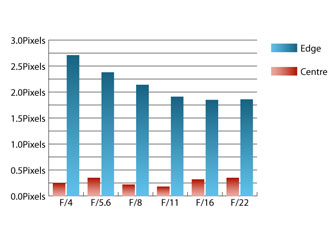 | |
| Chromatic Aberrations at 24mm | How to read our chartsChromatic aberration is the lens' inability to focus on the sensor or film all colours of visible light at the same point. Severe chromatic aberration gives a noticeable fringing or a halo effect around sharp edges within the picture. It can be cured in software.Apochromatic lenses have special lens elements (aspheric, extra-low dispersion etc) to minimize the problem, hence they usually cost more. For this review, the lens was tested on an Nikon D300 using Imatest. | |
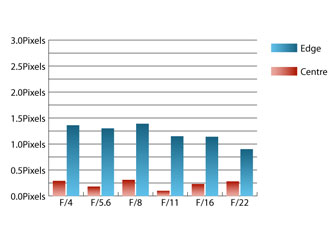 |
Falloff of illumination towards the corners of the frame is very well controlled for a wide angle lens. At 12mm and f/4 the corners are only 1.04 stops darker than the image centre and stopping down to f/5.6 results in visually uniform illumination. At 24mm the corners are onty 0.359stops darker than the centre and the lens only needs stopping down one third of a stop for visually uniform illumination.
Barrel distortion is present at both ends of the zoom range and is quite pronounced at the widest angle. At 12mm Imatest detected 7.37% barrelling which will be plain to see in images with straight lines towards the edges. At 24mm this drops to 1.99% barrel distortion, which is much less severe, but may still pose issues when straight lines are paramount. Luckily the distortion pattern is uniform across the frame, so should be relatively simple to correct in image editing software afterwards.
A deep flock-lined scalloped hood is supplied with the lens, which does an excellent job of keeping unwanted light off the front element, which may cause flare or loss of contrast. Strong point light sources towards the edge of the frame or just outside the imaging area may cause a little flare and loss of contrast, but for the most part, this lens is quite resilient and this will only occur in extreme circumstances.
Add your message
Login required
Please login here or if you've not registered, you can register here. Registering is safe, quick and free.
Please login here or if you've not registered, you can register here. Registering is safe, quick and free.
photodo Stats
1102 lenses
428 MTF tests
74 in-depth photodo reviews
100+ users join each day
Help the lens community by reviewing or rating a lens today via our lens search
428 MTF tests
74 in-depth photodo reviews
100+ users join each day
Help the lens community by reviewing or rating a lens today via our lens search
Latest Lens Reviews
- Chinon 28mm f/2.8 Vintage Lens Review
- Canon EF 70-200mm f/4L IS II USM Lens Review
- Samyang AF 85mm f/1.4 EF Review
- Sigma 70mm f/2.8 DG Macro Art Review
- Samyang AF 24mm f/2.8 FE Review
- Meike 50mm f/1.7 Review
- Tamron 70-210mm f/4 Di VC USD Review
- Lensbaby Burnside 35mm f/2.8 Review
- Asahi Super Takumar 50mm f/1.4 Review
- Asahi Super-Multi-Coated Takumar 135mm f/3.5 Review








